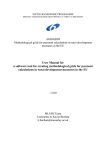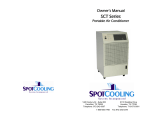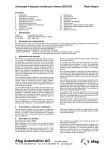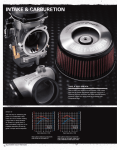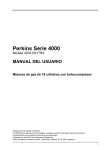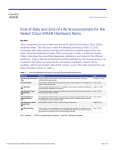Download Hoefer SE 615 and SE 675
Transcript
user manual SE 615 & SE 675 Hoefer SE 615 and SE 675 multiple gel casters um SE615-IM/Rev. A0/09-04 Page finder Introduction . . . . . . . . . . . . . . . . . . . . . . . . . . . . . . . .1 Gel sizes . . . . . . . . . . . . . . . . . . . . . . . . . . . . . 1 Homogenous and gradient gels . . . . . . . . . . . . . 1 Standard casting . . . . . . . . . . . . . . . . . . . . . . . 2 Casting with divider plates . . . . . . . . . . . . . . . . 3 Pouring second-dimension slab gels . . . . . . . . . 3 SE 615 and SE 675 components . . . . . . . . . . . 4 Setting up the caster . . . . . . . . . . . . . . . . . . . . . . . . .5 Preparing the caster . . . . . . . . . . . . . . . . . . . . . 5 Building the stack . . . . . . . . . . . . . . . . . . . . . . 6 Casting with divider plates . . . . . . . . . . . . . . . . . . . . .7 Pouring standard homogenous gels . . . . . . . . . . . . . . 9 Pouring standard gradient gels . . . . . . . . . . . . . . . . .11 Setting up the gradient maker. . . . . . . . . . . . . 11 Pouring gradient separation gels . . . . . . . . . . . 13 Pouring stacking gels . . . . . . . . . . . . . . . . . . . . . . . .15 Removing polymerized gels. . . . . . . . . . . . . . . . . . . .17 Troubleshooting . . . . . . . . . . . . . . . . . . . . . . . . . . . .18 Care and maintenance . . . . . . . . . . . . . . . . . . . . . . .20 Appendix A: Gel identification numbers . . . . . . . . . . .21 Appendix B: References . . . . . . . . . . . . . . . . . . . . . .21 Ordering information . . . . . . . . . . . . . . . . . . . . . . . . .22 • pi Safety warnings and precautions Acrylamide is a neurotoxin. • Wear gloves when handling acrylamide or polyacrylamide. • Wear a dust mask when weighing acrylamide or preparing acrylamide solutions. Protecting your equipment To keep your instrument in excellent condition, please take the following important steps: • Use water-saturated n-butanol for overlayering resolution gels during polymerization. Important! Most organic solvents including methanol, isobutanol, isopropanol, and even n-butanol will craze or cloud the acrylic plastic with prolonged exposure. Only use small amounts to overlay the gels. • pii • Avoid using small metal spatulas to separate the plates. Spatulas may chip the edges of glass plates and prevent them from sealing. • After casting, you may need to use a wedge to separate one glass-and-gel sandwich from another. Slip a Wonder Wedge in between adjacent sandwiches to separate them. Introduction Gel sizes The Hoefer™ SE 615 and SE 675 Multiple Gel Casters are designed for casting vertical slab acrylamide gels of homogenous or gradient concentration. Use the casters with 16 × 18 cm glass plates and 2 cm-wide spacers to cast 16 × 14 cm gels. Use 1-cm wide spacers to cast 16 × 16 cm gels for two-dimensional electrophoresis. The resulting gels are compatible with Hoefer SE 400, SE 600 and SE 600 Chroma Vertical Slab Gel Electrophoresis Units. Homogeneous and gradient gels The SE 615 and SE 675 can be used for casting both homogeneous and gradient gels. Gradient gels are cast through the port at the bottom of the caster. When casting homogeneous gels, the results are most consistent when the gels are cast from the bottom. The V-shaped region at the bottom of the casting unit allows the gel solution to rise evenly, producing identical gels. • p1 Standard casting In the standard casting procedure, a gel is cast between two glass plates held apart by a pair of spacers. (See Fig 2 on page 5.) The result can be pictured as a “sandwich,” with the gel between two glass plates. When you set up a vertical slab gel electrophoresis unit, you place the glass and gel sandwich in the electrophoresis unit. The maximum number of gels you can cast simultaneously using the standard casting procedure is shown in Table 1.1. Table 1-1. Maximum number of standard gels cast • p2 0.75-mm spacers 1.0-mm spacers 1.5-mm spacers SE 615 11 10 10 SE 675 4 4 4 Casting with divider plates You may find it useful to double the number of gels run simultaneously in one electrophoresis unit. This can be accomplished by casting a “club sandwich.” A club sandwich contains a notched glass divider plate and a second pair of spacers between the standard plates, and thus forms two layers of gel between three glass plates (see Fig 3 on page 8.) Divider plates are available for the SE 400 and SE 600. The maximum number of gels you can cast simultaneously, using divider plates (two gels per sandwich), is shown in Table 1-2. Table 1-2. Maximum number of gels cast with divider plates 0.75-mm spacers 1.0-mm spacers 1.5-mm spacers SE 615 14 14 12 SE 675 6 6 4 See Fig 1 on page 4 to identify the components of the multiple gel casters. For information on parts, accessories and related equipment, see page 22. Pouring second-dimension slab gels When preparing second-dimension slab gels in the multiple casters, it is important to pour the slabs to the correct height. If you are using IPG strips, you do not need a stacking gel. Pour the second-dimension gel to 0.5 –1.0 cm below the top of the sandwich for standard casting, or 1 cm below the notch if you are casting with divider plates. This allows ample room to hold the IPG strips between the two glass plates. Use 1.0- or 1.5-mm spacers with IPG strips. • p3 1 6 5 2 7 3 4 8 9 Fig 1. Components of the SE 615 and 675 Multiple Gel Casters. 0 8 1 ! SE 615 and 675 components no. description 1 Caster body, includes faceplate 2 Spring clamp (4) 3 Foam cord gasket 4 Silicone displacement block* 5 Acrylic spacer block 6 Comb 7 Polycarbonate filler sheet 8 Glass plate 9 Spacer 10 Inlet port 11 Nylon thumb screw *A small silicone displacement block is also available for the SE 675. • p4 Setting up the caster Fig 2. Building a glass sandwich for standard casting. caster glass plate spacer one sandwich glass plate wax paper or polycarbonate sheet Preparing the caster 1 If the faceplate is attached to the caster, remove it. Remove the four side clamps, loosen the two thumb screws, and slide off the faceplate. 2 Note: Do not block the red inlet port at the bottom of the faceplate. Remove the foam cord gasket. Apply a light coat of Gel Seal lubricant and replace the gasket. 3 When casting gradient gels, attach the tubing from the gradient maker to the inlet port at the bottom of the faceplate. Homogeneous gels may also be cast through this port. If casting homogeneous gels from the top, insert the appropriate displacement block in the open, V-shaped region at the bottom of the chamber. 4 Place the open caster in a horizontal position with its back on the bench top. • p5 Building the stack Note: To make separation of polymerized gel sandwiches easier, place wax paper sheets in the caster between each set of glass sandwiches. Note: When analyzing a large number of gels, you may find it useful to include gel identification numbers into the polymerized gel. See the appendix on page 21 for directions on making gel identification tags. Lightly wet and place the tags in the lower corner of the gel sandwich during stack assembly. Note: If you use polycarbonate sheets instead of wax paper between each sandwich, the caster holds fewer sandwiches. 1 Place a polycarbonate sheet in the caster so that 1/3 of the sheet extends out of the top. You can use this sheet as a lever when inserting filler sheets after all sandwiches are in place. All remaining components fit flush against the bottom and sides. 2 Place a sheet of wax paper on the polycarbonate sheet. Build the first sandwich into the caster. 3 Place a sheet of wax paper on top of the sandwich and build the next sandwich. 4 Repeat step 3, alternating wax paper and gel sandwiches. Over the final sandwich, lay a polycarbonate sheet instead of wax paper so that the gel solution level is visible through the faceplate. 5 Place the faceplate on the caster and make sure the stack fits snugly, about 0.5 mm above the edge of the caster. If necessary, adjust the number of extra polycarbonate sheets, acrylic spacer blocks, glass plates and sandwiches to obtain a snug fit. 6 Make sure the spacers are straight and along the edges of the glass plates. Use the Spacer Mate to correct the alignment if necessary. If necessary, take the faceplate off and make sure all edges of the stack components are flush. Press on those that are sticking out until all edges are flush and replace the faceplate on the caster. 7 Secure the faceplate with the four spring clamps and tighten the bottom thumb screws. • p6 Casting with divider plates To double the number of gels run simultaneously on the SE 600 and related units, place a notched glass divider plate and another pair of spacers between the standard glass plates. The result is a “club sandwich,” with two layers of gel formed by the three glass plates. To use divider plates, follow the directions in “Pouring standard homogeneous gels” on page 9 or “Pouring standard gradient gels” on page 11. When calculating solution volumes, use the formula on page 9. When stacking glass sandwiches, use the following procedure. 1 Stack glass sandwiches in the caster, using one club sandwich for each two gels you will cast. Fill extra space with acrylic blocks, glass plates and polycarbonate sheets. 2 Slide in one polycarbonate sheet against the back. 3 Slide in a glass club sandwich. (See Fig 3.) To construct a club sandwich, slide in one rectangular glass plate and place spacers along each of the two side edges. Slide in a notched divider glass plate and place spacers along each of the side edges. Finally, slide in a second rectangular glass plate. • p7 4 Place a polycarbonate sheet or wax paper on top of the club sandwich. Repeat step 3, alternating wax paper and club sandwiches. 5 Note: For optimum visibility, place a polycarbonate sheet against the faceplate. After the last club sandwich, add acrylic spacer blocks and extra polycarbonate sheets until the entire stack is approximately 0.5 mm above the rim of the box. Fig 3. Constructing a “club sandwich” for casting with divider plates. glass plate spacer notched divider plate spacer one club sandwich glass plate wax paper or polycarbonate sheet additional club sandwiches • p8 Warning! Acrylamide is a neurotoxin. Wear gloves when handling acrylamide or polyacrylamide. Wear a dust mask when weighing acrylamide or preparing acrylamide stocks. Pouring standard homogeneous gels Table 4-1. Gel casters and volume required gel caster required volume (ml) gradient maker size* SE 615 190 –500 SG 500 SE 675 60 –150 SG 100 or SG 500 *Actual size depends on calculated volume 1 Prepare and degas enough monomer solution to fill all sandwiches to the level of the notched plate. The following formula allows extra solution to fill the space between the sandwich and the chamber: Monomer vol. = height × width × spacer × total number of × 1.1 (ml) (cm) (cm) thickness (cm) gel sandwiches Note: The 1.1 multiplier in this formula assures enough solution to fill dead volume. No stacking gel. Fill solution to just below the top of the notched plate. If air pockets form, remove with a pipette or syringe. Introduce a comb, at a slight angle, into each sandwich, taking care not to trap air under the teeth. Stacking gel. Fill solution to 4 cm below the top of the rectangular glass plate. This height allows 1 cm of stacking gel below the wells. Pour the gel and apply an overlay. After the gel is set, prepare the stacking gel as described on page 15. 2-D electrophoresis. Fill solution to about 1.0 cm below the top of the rectangular glass plate. This height allows 4 to 5 mm of space for the IPG strip and an agarose seal. Overlay the separating gel as described in step 3. • p9 2 Caution! Isobutanol crazes or clouds the acrylic caster walls, making it difficult to see the gels. Add initiator and catalyst, and pour the solution into the glass sandwiches from the top. The solution flows from one sandwich to another through the groove at the bottom of the caster and rises to the same level in all sandwiches. Pour slowly to avoid overfilling. 3 After reaching the final level, overlay each gel sandwich with 300 µl of water-saturated n-butanol or buffer. Use the same amount of overlay on each gel sandwich to assure that all the gels polymerize to the same heights. Pour the liquid gently, taking care not to disrupt the gel surface. After polymerization is complete, remove the n-butanol and replace it with buffer or add stacking gel. Water-saturated n-butanol will cloud acrylic parts if used in large amounts or for long periods. 4 Allow the gels to polymerize for at least an hour. To remove the polymerized gels, see “Removing polymerized gels” on page 17. To add a stacking gel, see “Pouring stacking gels” on page 15. • p10 Pouring standard gradient gels See Fig 1 on page 4 for a diagram of the caster components. See “Setting up the caster” on page 5 for recommended solution volumes. Setting up the gradient maker 1 Prepare a 50% glycerol displacement solution containing a small amount of bromophenol blue: approximately 75 ml for the SE 615 and 35 ml for the SE 675. 2 Calculate the amount of gradient solution you will need by referring to the formula on page 9. For one-dimensional gels: Use a 12-cm separation gel with a 4-cm stacking gel. For two-dimensional gels using IPG strips: Calculate the amount of solution needed to fill the sandwiches to approximately 0.5 –1.0 cm below the top of the plates. 3 Set up the peristaltic pump. Using a graduated cylinder and water, adjust the flow rate so that the volume of the gradient separation solution plus the volume of the glycerol solution will be completely delivered in 10 –15 minutes. 4 Choose a gradient maker that holds no more than four times the total volume of gradient solution to be poured. Check that the gradient maker is clean and that the outlet and mixing port are free of polymerized acrylamide. • p11 5 Assemble the gradient components. (See Fig 5.) a. Close all gradient maker valves and place a stir bar in the mixing chamber, the one with the tube connector port. b. Attach one end of a piece of tubing to the outlet of the gradient maker. c. Run the other end of the tubing through the peristaltic pump and attach it to a tubing connector. d. Use a second piece of tubing to attach the tubing connector to the red inlet port at the bottom of the caster. Fig 5. Gradient making system connections. reservoir chamber multiple gel caster gradient maker peristaltic pump • p12 mixing chamber magnetic stirrer Pouring gradient separation gels Warning! Acrylamide is a neurotoxin. Wear gloves when handling acrylamide or polyacrylamide. Wear a dust mask when weighing acrylamide or preparing acrylamide stocks. 1 Prepare and degas the two monomer solutions for the gradient maker. Add glycerol or sucrose to the solution of higher acrylamide concentration to stabilize the gradient as the solution is pumped in. Decrease the concentration of initiator so that polymerization occurs from top to bottom. This minimizes convective mixing due to the heat generated by polymerization. 2 Close both the mixing port and outlet port, if appropriate, on the gradient maker. Clamp the tubing from the outlet when using the SG 500. 3 Add initiator and catalyst, and immediately pour the light (low concentration) acrylamide solution into the mixing chamber—the chamber with the outlet port. Open the mixing valve slightly to allow the connecting channel to fill and force out air bubbles. Close the valve again and pour the heavy (high concentration) acrylamide solution into the reservoir chamber. 4 Start the magnetic stirrer and unclamp or open the outlet valve. Start the pump and open the mixing valve. • p13 5 When almost all the acrylamide solution is drained from the gradient maker, stop the pump and close the mixing valve. Tilt the gradient maker towards the outlet side and remove the last few milliliters of mix. Do not allow any air bubbles to enter the tubing. 6 Add the glycerol displacement solution to the mixing chamber and start the pump. Make sure no bubbles are introduced. Pump until the bottom of the caster is filled with displacement solution to just below the glass plates, then turn off the pump. Clamp off the tubing to the red inlet port of the caster. 7 Note: Isobutanol clouds the acrylic, making it difficult to see the gels. Overlay each separate sandwich with 300 µl of watersaturated n-butanol or buffer. Use the same amount of overlay on each gel to assure that all the gels polymerize to the same height. Carefully and gently pipette the liquid, taking care not to disrupt the gel surface. After polymerization, remove the n-butanol. Replace it with buffer or add a stacking gel. 8 Allow the gels to polymerize for at least an hour. To remove the polymerized gels, see “Removing polymerized gels” on page 17. To add a stacking gel, see “Pouring stacking gels” on page 15. • p14 Pouring stacking gels You may add stacking gels to the entire set of polymerized gels —homogeneous or gradient— while the sandwiches are still in the casting box, or you may add stacking gel to individual gels immediately prior to use. For optimal resolution, add the stacking gel at the last minute to prevent diffusion of buffers between the two gel layers. 1 If you are pouring stacking gels later, skip to step 1 under “Removing polymerized gels” on page 17. If you are pouring stacking gels now, calculate the volume of stacking gel monomer solution needed by referring to the following formula: Monomer vol. = height × width × thickness × total number of (ml) (cm) (cm) (cm) stacking gels where • Height is the distance between the separating gel and the top of the plates • Width is the distance between the spacers 2 Rinse off the water-saturated n-butanol overlay with distilled water or Tris buffer and invert the caster to drain it. Repeat this 2–3 times. 3 Degas the stacking gel monomer solution and add catalyst and initiator. • p15 4 Replace the caster in a vertical position. Make sure the surface of the separating gel is free of liquid. Use a pipette to fill each sandwich individually with stacking-gel monomer solution. 5 Hold a comb, attached to a comb back, at a 45° angle and centered within the sandwich. Insert one end into the gel so that the end tooth is almost completely inserted. Slowly lower the remaining comb teeth in one by one, rotating the comb gradually downward until it is in a horizontal position. Refer to Fig 1 on page 4 for the final position of the comb. Repeat this for each sandwich. 6 Note: Oxygen inhibits gel polymerization. Do not trap air bubbles underneath the comb teeth. Note: Use gels with stacking gels immediately. Do not store. • p16 Allow the stacking gels to polymerize for at least one hour. To remove the polymerized gels, see “Removing polymerized gels” on page 17. Removing polymerized gels 1 After the gels have polymerized, place the caster in a horizontal position. If you poured stacking gels, leave the combs in place. Remove the faceplate. 2 Tip the caster to pour off the glycerol solution. 3 Note: The SDS buffer makes the glass plates slippery. Note: Do not use metal spatulas to separate the sandwiches. Narrow metal spatulas often chip the edges of glass plates, making the plate ineffective for sealing into the electrophoresis tank. Note: Separate the sandwiches from one another before placing the gels in the refrigerator. Slide the stack of sandwiches, acrylic blocks, and polycarbonate sheets out of the caster. Remove the acrylic blocks and polycarbonate sheets from the top of the stack. 4 Carefully remove individual glass and gel sandwiches from the stack. If necessary, insert a Wonder Wedge between adjacent sandwiches to separate them. Work slowly and cautiously when prying apart adjacent sandwiches after polymerization. 5 Rinse the caster and polycarbonate sheets, as described in “Care and maintenance” on page 20. To store gels for future use Rinse the individual sandwiches with distilled water. Fill cassettes with gel storage buffer. Wrap gel sandwiches you are not using at this time in plastic wrap and store them in the refrigerator. To use gels immediately 1 Gently remove the combs by pulling them upward and out of the gel sandwich. 2 Fill the wells with SDS Electrophoresis buffer. 3 Load samples and complete assembly. Refer to the user manuals that come with SE 600 or SE 400 Series electrophoresis systems. • p17 Troubleshooting symptom possible cause recommended action 1. Gels adhere to glass plates when opening sandwich. Dirt, grease or fingerprints on plates. Soak plates in a strong laboratory detergent; rinse well in distilled water. Handle with gloves only. 2. Gels cast simultaneously are different sizes. Different amounts of overlay were used on the separation gels before polymerization. Use the same amount of overlay on all separation gels. Add the overlay as rapidly as possible. 3. Caster leaks. Gasket leaks. Apply a light film of Gel Seal to the gasket each time the unit is used. Gasket damaged. Check the foam gasket for nicks or wear and replace if necessary. Stack too tall. Remove filler plates or gel sandwiches until the stack top is just below the level of the caster wall. Bubbles trapped under gel sandwiches. Pour the monomer solution into one sandwich and allow the groove in the plug to evenly distribute the solution. Polymerized gel in groove. Make sure the groove in the triangular plug is clean and clear of material. Insufficient time for gel levels to stabilize. Wait one minute before overlaying the gels. Add the same amount of overlay to each sandwich. Air bubbles under comb teeth. Remove air pockets before inserting combs. Slide comb into solution at an angle. If comb must be removed, add more monomer solution before reinserting the comb. Insufficient polymerization. Allow the gel to set for a minimum of 1 hour. Comb removed too abruptly. Slowly remove the comb at a slight angle to prevent damaging the gel. Poor polymerization. Degas stacking gel solution. Increase catalysts up to 0.1% v/v TEMED, 0.1% v/v APS. 6. Gel sandwiches difficult to separate. No wax paper between glass plates. Place wax paper between sandwiches in the stack. 7. Uneven gradient gels. Uneven layering. Add sucrose or glycerol to the heavy monomer solution. Add a small amount of bromophenol blue to the heavy solution to track gradient formation. 4. Gel heights uneven. 5. Sample wells damaged or leak. Decrease the pump rate. • p18 symptom possible cause recommended action 8. No polymerization of SDS gel (or incomplete polymerization.) Insufficient APS or TEMED Increase both APS and TEMED by 30–50% APS solution is old. Make up fresh APS each day. APS stack is wet APS is hygroscopic. Open a fresh bottle. 02 in gel solution. Degas at least 10 minutes. Solutions at low temperature. Make sure all solutions are at room temperature (20–30 °C). TEMED is old. Use new TEMED. 9. Gel too soft. Not enough crosslinker. Crosslinker should be 2.6% C for standard SDS gels where g bis × 100 %C = (g monomer + g bis) 10. Gel is brittle. Too much bis. See #9 above. 11. Gel is white. Too much bis. Check concentrations of solutions. See #9 above. 12. Gel contains swirls, polymerization artifacts. Too much catalyst: gel polymerized in < 10 min. Reduce both APS and TEMED by 25%. Not enough catalyst: gel polymerized in > 50 min. Increase both APS and TEMED by 50%. Also see #8. 13. Bands are diffuse or broad. 14. Protein mobilities not consistent. Solutions not mixed. Mix thoroughly after adding TEMED. Sample doesn’t contain same buffer as stacking gel. Use the same buffer for the sample as for the stacking gel. Too much TEMED or APS. Reduce concentrations by 25% SDS or sample buffer is old. Use fresh solutions. Poor interface between separation gel and stacking gel. Remove all liquid from the surface of the separation gel before adding the stacking gel solutions. Incomplete polymerization. See #8. Aged gels or acrylamide. Do not store liquid acrylamide more than 3 months. Use gels within 1–2 weeks of casting. Use gels with stackers immediately. 15. Heavy background during silver staining. Gas in gel. Degas gel solutions at least 10 minutes. Acrylamide or bis contain acrylic acid. Use reagents specified as electrophoresis purity. Water is impure. Use only double-distilled water. • p19 Care and maintenance • Do not autoclave or heat any part above 45 °C. • Do not expose the caster or its parts to organic solvents. Cleaning Rinse the caster, faceplate, silicone plugs and polycarbonate sheets in dilute detergent and rinse with distilled water. Allow the unit to air dry completely. • p20 Appendix A: Gel identification numbers For positive identification of gels, label each slab by incorporating a small label printed on thin filter paper in the bottom corner of the gel. Use a carbon typewriter ribbon, photocopier or laser printer to make these labels, since many liquidbased inks are electrophoresed off paper during an SDS electrophoresis run. A variety of numbering schemes are possible. In our experience the easiest uses three parts as follows: • An upper-case letter to identify the investigator or an extended gel series. • A two- or three-digit serial number to identify the slab gel batch. • A lower-case letter to identify a gel in the batch. Since a maximum of 14 gels can be made in a batch, use the letters a–n. The resulting numbers, in the format A63a, A63b...., etc., provide a useful system for keeping track of and cross-indexing experiments and gel production. Appendix B: References Laemmli, U.K. 1979. Nature (London) 227: 680 – 685. SDS-PAGE and IEF Handbook. • p21 Ordering information product qty. SE 615 Multiple Gel Caster Kit, 10 gels Includes 20 glass plates, space-saver plate, 5 filler sheets, 100 sheets of wax paper, and Spacer-Mate alignment template. (Order combs and spacers separately.) 1 SE615 SE 675 Multiple Gel Caster Kit, 4 gels Includes 8 glass plates, 3 space-saver plates, 5 filler sheets, 100 sheets of wax paper, and Spacer-Mate alignment template and filler plugs. (Order combs and spacers separately.) 1 SE675 Foam cord gasket, 61 cm × 4.5 mm OD 1 SE208 Red inlet port 4 XP010 Red spring clamps 4 SE253 Glass plates, 18 × 16 cm 2 SE6102 Notched divider glass plates, 18 × 16 cm 1 SE6102D Acrylic block, 11 mm thick, 18 × 16 cm 1 SE612 Polycarbonate filler sheets 5 SE613 100 SE614 Wax paper, precut sheets, 18 × 16 cm Spacer-Mate template for aligning spacers 3 Nylon thumb screws • p22 code no. 12 SE6119SM SE6003U-2 Silicone filler plug, SE 615 1 SE618 Silicone filler plug set, SE 675 Includes 1 large and 1 small plug 1 SE678 Gel Seal, 1/4 oz. tube 1 SE6070 product qty. code no. Related products SE 100 PlateMate, plate washer and storage unit 1 SE100 SG 100 Gradient Maker, 100 ml total volume 1 SG100 SG 500 Gradient maker, 500 ml total volume 1 SG500 Wonder Wedge 1 SE1514 Spacers length (cm) thickness (mm) width (cm) 16 0.75 2 2 SE6119-2-.75 16 1.0 2 2 SE6119-2-1.0 16 1.5 2 2 SE6119-2-1.5 16 1.0 1 2 SE6118-2-1.0 16 1.5 1 2 SE6118-2-1.5 Combs Teflon™ Combs for the SE 615 and SE 675 are available for the slab thicknesses 0.75, 1.0, and 1.5 mm with 28, 20, 15, 12, and 10 wells. Blank combs and single reference well combs are also available. Please see the Hoefer catalog under SE 600 accessories. • p23 Hoefer, Inc. 953 Indiana Street San Francisco, CA 94107 USA www.hoeferinc.com Teflon is a trademark of E. I. duPont de Nemours and Co. © 2004 Hoefer, Inc.— All rights reserved. Printed in the USA

































